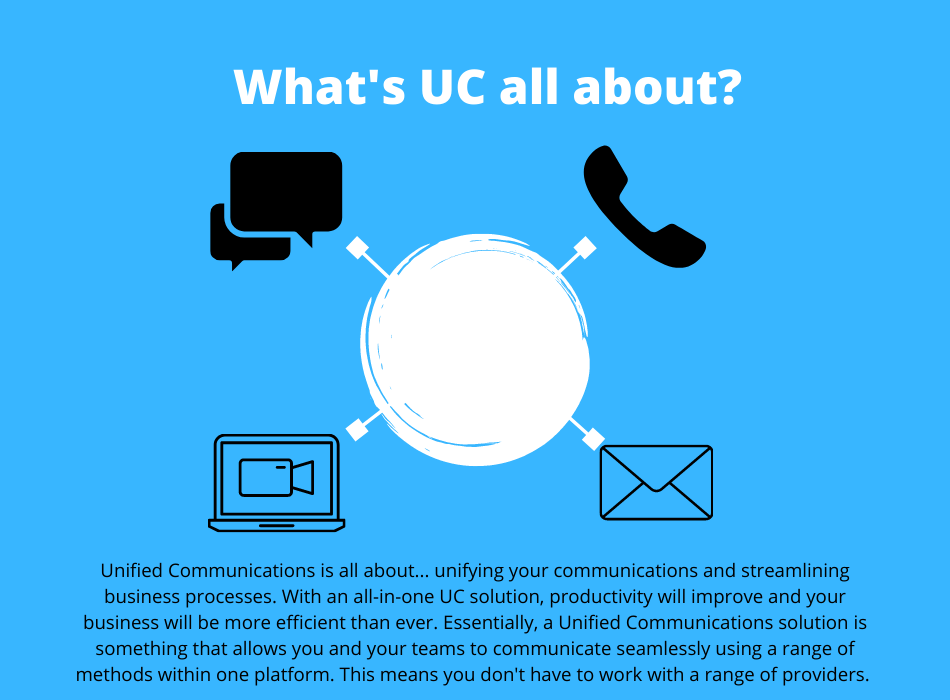You’ve probably already heard of Unified Communications, or UC, or you likely already understand the basics of how it works without knowing the terms. For example, if you’ve familiarised yourself with receiving voicemails via email, you’re probably already using a Unified Communications solution.
But how does all this work? That’s what I’m going to explain in this blog post. There are several points to consider:
- What does Unified Communications mean?
- How does Unified Communications work?
- What are some examples of Unified Communications platforms?
- What are the benefits of Unified Communications?
What Does Unified Communications Mean?
The term Unified Communications sounds very complicated, but the basic meaning of it is nowhere near as complicated as you might think. The most basic definition of Unified Communications is as follows:
“Integrated communications to optimise processes, improve efficiency, and increase user productivity.”
Not so long ago, you would have separate providers for everything; a separate telecoms provider, a separate email provider, and perhaps another company looking after the rest of your IT. In fact, your setup right now might actually be similar to this. On the other hand, where UC is concerned, you will normally have one provider who manages everything for you and integrates all your communication and IT services.
Considering types of communication only, such as instant messaging and email, Unified Communications is all about integrating everything into one platform. It’s all about making communicating easier and more efficiently.
Integrating all of your communication services enables free-flowing collaboration without any latency. For example, your teams can work on the same files simultaneously, rather than having to send one version of a file back and forth.

Unifying your communications also reduces your dependency upon certain devices and pieces of software. Everything is integrated, so you can still communicate fluidly no matter what. For instance, if your IP handset stopped working, you could still communicate with colleagues via a soft client or email.
I think it suffice to say that unified communications is all about:
- Combining and integrating solutions, so you’re not reliant on particular devices or applications
- Making it easier for your teams to collaborate on projects
- Ensuring your business communications are more robust so your business isn’t badly affected if something stops working (e.g. phones)

How Does Unified Communications Work?
So we have a really good idea of what unified communications means, but how do unified communications actually work? In this section, I’m going to explain what solutions would typically be combined or integrated and how they would work together. After, I’ll offer some examples of solutions some businesses use.
Unified communications is an concept that covers integrating all of your business’s communication services. For example:
- Instant messaging
- Voice (often VoIP)
- Audio and video conferencing
- Document sharing
Unified communications is all about giving teams the ability to work together regardless of their physical locations. For example, even if a member of a team is out of the office for the day, they should be able to seamlessly collaborate with the rest of their team despite this.

Unifying your communications is made possible through integrating your solutions and using as few solutions as possible. For instance, the Office Suite works fantastically together, making communications and collaboration easy. For instance, employees can edit the same Excel document at any given time. Furthermore, Outlook integrates with Teams, so there you have an off-the-shelf solution that integrates email, instant messaging, and audio and video conferencing.
So that’s an example of how multiple pieces of software can integrate to give your business unified communications. But for true unified communications, you also need hardware that has multiple purposes.
I would say that a smartphone is the perfect example of a device enabling unified communications, even more so than a PC or laptop in some respects. A smartphone, first and foremost, is very portable. Furthermore, it’s a device with a microphone and speaker built in. To top that off, its connectivity allows you to communicate with other team members in numerous ways (video conferencing, instant messaging, and email are just three examples).
In the next section of this blog post, I’m going to give some examples of unified communications platforms and how they work.
What Are Some Examples of Unified Communications Platforms?
There are different types of unified communications platforms out there that can enhance the way your teams communicate and collaborate. For example:
- Cloud-based UC
- Mobile UC
Here’s what each of these terms means.
Cloud-Based UC
If you follow the cloud-based unified communications model then all your software and data is hosted in the cloud. This means that you can access your data and software applications no matter where you are on any device.
This is an excellent option if you have team members working in numerous locations on a variety of devices. For instance, a person who works in the office some of the time and at home the rest of the time. They’re likely to be using different devices at work and at home, so a cloud-based solution is a good solution.
A good example of a cloud-based UC solution is Microsoft 365. Microsoft 365 is a subscription-based, cloud-first solution offered by Microsoft. There are different levels available, some of which allow you to download the Office Suite to your PC. However, as a cloud-first solution, this means you can use all the Microsoft software entirely online should you so wish. For example, you can schedule Teams meetings through Outlook, or collaborate concurrently on the same Word document.
Mobile UC
Mobile unified communications is all about integrating your mobile telephony with the rest of your communications services. For instance, features such as voicemail to email are examples of how your telephone system can integrate with your other communications services.
If you have a team that are often working outside of the office, mobile UC is very important. As it says on the tin, it’s all about being mobile. It’s about ensuring that your team can still communicate effectively even while they’re out of the office.
Have you heard of BYOD? This links into mobile unified communications. The acronym BYOD stands for Bring Your Own Device. A lot of businesses see BYOD as a good option because it’s cost-effective and can boost productivity because your employees are using devices that they’re comfortable with. This is why a lot of UC solutions are mobile-friendly; so they can be used comfortably on smartphones.
What Are The Benefits Of Unified Communications?
I actually wrote a blog post previously, What Are The Benefits Of Unified Communications, which was a comprehensive exploration of the benefits of unifying your communication solutions. In this blog post, however, I thought we’d just have a quick look at the benefits of UC solutions.
These are the benefits of unified communications:
- Improved productivity
- Easier expansion and growth
- Flexibility to work no matter where you are
- Lower costs by choosing a unified solution
- All-in-one solution rather than numerous providers
Let’s have a closer look at each of these benefits.
- Improved Productivity: Your teams will be more productive if you unify your communication solutions. With unified solutions collaborating on the same files is easier, no matter where team members physically are or the devices that they’re using. Staff can work on the same files concurrently, meaning there’s none of the latency associated with sending an email with an attachment and waiting for the modified document to be returned.
- Easier Expansion And Growth: By unifying your communications solutions, you’re consolidating numerous solutions into one platform. When you’re using just the one platform, it is much easier for your business to grow. You’re growing with one definitive solution rather than a multitude of platforms that don’t work together very well.
- Flexibility To Work No Matter Where You Are: Unified communications gives your team the ability to work together efficiently no matter where the team members are actually based. For instance, if one team member cannot make it into work, they can still communicate and collaborate by accessing your platforms via a web browser.
- Lower Costs Usually With A Unified Solution: Your costs will usually be lower when you are using a unified solution. This is because you have multiple services (instant messaging, voice, video, and email, for instance) all integrated into the one platform rather than paying for multiple platforms.
- All-In-One Solution Rather Than Numerous Providers: Numerous providers can just make everything so much harder. Your providers won’t work together effectively which ultimately causes problems for your business. If you have one provider for everything and unified communications, it makes life so much easier.
